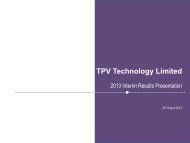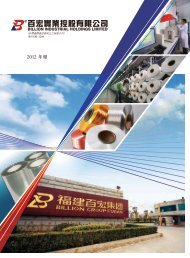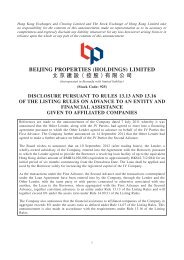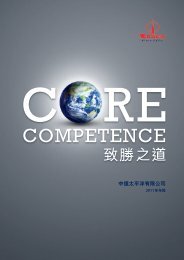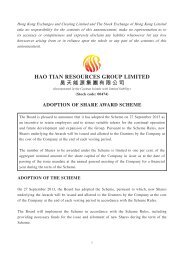Annual Report - QuamIR
Annual Report - QuamIR
Annual Report - QuamIR
You also want an ePaper? Increase the reach of your titles
YUMPU automatically turns print PDFs into web optimized ePapers that Google loves.
Notes to the Consolidated Financial Statements (Continued)<br />
<br />
2 Summary of significant accounting policies (Continued)<br />
2.12 Impairment of investments in subsidiaries,<br />
associated companies, jointly controlled<br />
entities and non-financial assets<br />
Assets that have an indefinite useful life or intangible assets<br />
not ready to use are not subject to amortisation and are tested<br />
annually for impairment. Assets which are subject to amortisation<br />
are reviewed for impairment whenever events or changes in<br />
circumstances indicate that the carrying amount may not be<br />
recoverable. An impairment loss is recognised for the amount<br />
by which the asset’s carrying amount exceeds its recoverable<br />
amount. The recoverable amount is the higher of an asset’s fair<br />
value less costs to sell and value in use. For the purposes of<br />
assessing impairment, assets are grouped at the lowest levels for<br />
which there are separately identifiable cash flows (cash-generating<br />
units). Non-financial assets other than goodwill that suffered an<br />
impairment are reviewed for possible reversal of the impairment<br />
at each reporting date.<br />
2.13 Non-current assets (or disposal groups) held<br />
for sale<br />
Non-current assets (or disposal groups) are classified as assets<br />
held for sale when their carrying amount is to be recovered<br />
principally through a sale transaction and a sale is considered<br />
highly probable. They are stated at the lower of carrying amount<br />
and fair value less costs to sell.<br />
2.14 Construction contracts<br />
Contract costs are recognised as an expense by reference to<br />
the stage of completion of the contract activity at the end of the<br />
reporting period. When the outcome of a construction contract<br />
cannot be estimated reliably, contract revenue is recognised<br />
only to the extent of contract costs incurred that are likely to be<br />
recoverable. When the outcome of a construction contract can<br />
be estimated reliably and it is probable that the contract will be<br />
profitable, contract revenue is recognised over the period of<br />
the contract by reference to the stage of completion. When it<br />
is probable that total contract costs will exceed total contract<br />
revenue, the expected loss is recognised as an expense<br />
immediately.<br />
2 <br />
2.12 <br />
<br />
<br />
<br />
<br />
<br />
<br />
<br />
<br />
<br />
<br />
<br />
<br />
<br />
<br />
<br />
2.13 <br />
<br />
<br />
<br />
<br />
<br />
<br />
<br />
2.14 <br />
<br />
<br />
<br />
<br />
<br />
<br />
<br />
<br />
<br />
Variations in contract work, claims and incentive payments are<br />
included in contract revenue to the extent that may have been<br />
agreed with the customer and are capable of being reliably<br />
measured.<br />
<br />
<br />
<br />
•<br />
95




